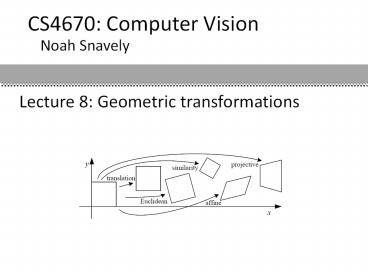Lecture 8: Geometric transformations - PowerPoint PPT Presentation
Title:
Lecture 8: Geometric transformations
Description:
Noah Snavely Lecture 8: Geometric transformations CS4670: Computer Vision Inverse Warping Get each pixel g(x ) from its corresponding location x = h(x) in f(x ... – PowerPoint PPT presentation
Number of Views:263
Avg rating:3.0/5.0
Title: Lecture 8: Geometric transformations
1
Lecture 8 Geometric transformations
CS4670 Computer Vision
Noah Snavely
2
Reading
- Szeliski Chapter 3.6
3
Announcements
- Project 2 out today, due Oct. 4
- (demo at end of class today)
4
Image alignment
Why dont these image line up exactly?
5
What is the geometric relationship between these
two images?
Answer Similarity transformation (translation,
rotation, uniform scale)
6
What is the geometric relationship between these
two images?
7
What is the geometric relationship between these
two images?
Very important for creating mosaics!
8
Image Warping
- image filtering change range of image
- g(x) h(f(x))
- image warping change domain of image
- g(x) f(h(x))
9
Image Warping
- image filtering change range of image
- g(x) h(f(x))
- image warping change domain of image
- g(x) f(h(x))
f
g
f
g
10
Parametric (global) warping
- Examples of parametric warps
aspect
rotation
translation
11
Parametric (global) warping
p (x,y)
p (x,y)
- Transformation T is a coordinate-changing
machine - p T(p)
- What does it mean that T is global?
- Is the same for any point p
- can be described by just a few numbers
(parameters) - Lets consider linear xforms (can be represented
by a 2D matrix)
12
Common linear transformations
- Uniform scaling by s
(0,0)
(0,0)
What is the inverse?
13
Common linear transformations
- Rotation by angle ? (about the origin)
?
(0,0)
(0,0)
What is the inverse?
For rotations
14
2x2 Matrices
- What types of transformations can be represented
with a 2x2 matrix?
2D mirror about Y axis?
2D mirror across line y x?
15
2x2 Matrices
- What types of transformations can be represented
with a 2x2 matrix?
2D Translation?
NO!
Translation is not a linear operation on 2D
coordinates
16
All 2D Linear Transformations
- Linear transformations are combinations of
- Scale,
- Rotation,
- Shear, and
- Mirror
- Properties of linear transformations
- Origin maps to origin
- Lines map to lines
- Parallel lines remain parallel
- Ratios are preserved
- Closed under composition
17
Homogeneous coordinates
(x, y, w)
Trick add one more coordinate
homogeneous plane
(x/w, y/w, 1)
homogeneous image coordinates
Converting from homogeneous coordinates
18
Translation
- Solution homogeneous coordinates to the rescue
19
Affine transformations
any transformation with last row 0 0 1 we
call an affine transformation
20
Basic affine transformations
Translate
Scale
2D in-plane rotation
Shear
21
Affine Transformations
- Affine transformations are combinations of
- Linear transformations, and
- Translations
- Properties of affine transformations
- Origin does not necessarily map to origin
- Lines map to lines
- Parallel lines remain parallel
- Ratios are preserved
- Closed under composition
22
Is this an affine transformation?
23
Where do we go from here?
what happens when we mess with this row?
affine transformation
24
Projective Transformations aka Homographies aka
Planar Perspective Maps
Called a homography (or planar perspective map)
25
Homographies
- Example on board
26
Image warping with homographies
image plane in front
image plane below
27
Homographies
28
Projective Transformations
- Projective transformations
- Affine transformations, and
- Projective warps
- Properties of projective transformations
- Origin does not necessarily map to origin
- Lines map to lines
- Parallel lines do not necessarily remain parallel
- Ratios are not preserved
- Closed under composition
29
2D image transformations
- These transformations are a nested set of groups
- Closed under composition and inverse is a member
30
Image Warping
- Given a coordinate xform (x,y) T(x,y) and a
source image f(x,y), how do we compute an xformed
image g(x,y) f(T(x,y))?
T(x,y)
y
y
x
x
f(x,y)
g(x,y)
31
Forward Warping
- Send each pixel f(x) to its corresponding
location (x,y) T(x,y) in g(x,y)
- What if pixel lands between two pixels?
T(x,y)
y
y
x
x
f(x,y)
g(x,y)
32
Forward Warping
- Send each pixel f(x,y) to its corresponding
location x h(x,y) in g(x,y)
- What if pixel lands between two pixels?
- Answer add contribution to several pixels,
normalize later (splatting) - Can still result in holes
T(x,y)
y
y
x
x
f(x,y)
g(x,y)
33
Inverse Warping
- Get each pixel g(x,y) from its corresponding
location (x,y) T-1(x,y) in f(x,y)
- Requires taking the inverse of the transform
- What if pixel comes from between two pixels?
T-1(x,y)
y
y
x
x
f(x,y)
g(x,y)
34
Inverse Warping
- Get each pixel g(x) from its corresponding
location x h(x) in f(x)
- What if pixel comes from between two pixels?
- Answer resample color value from interpolated
(prefiltered) source image
T-1(x,y)
y
y
x
x
f(x,y)
g(x,y)
35
Interpolation
- Possible interpolation filters
- nearest neighbor
- bilinear
- bicubic (interpolating)
- sinc
- Needed to prevent jaggies and texture crawl
- (with prefiltering)































